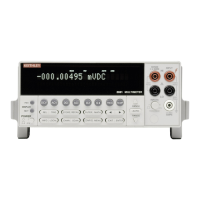IEEE-488 Reference
4-136
:ACQuire
[:SENSe[1]]:CURRent:AC:REFerence:ACQuire Acquire Reference for ACI
[:SENSe[1]]:CURRent[:DC]:REFerence:ACQuire Acquire Reference for DCI
[:SENSe[1]]:VOLTage:AC:REFerence:ACQuire Acquire Reference for ACV
[:SENSe[1]]:VOLTage[:DC]:REFerence:ACQuire Acquire Reference for DCV
[:SENSe[1]]:RESistance:REFerence:ACQuire Acquire Reference for Ω2
[:SENSe[1]]:FRESistance:REFerence:ACQuire Acquire Reference for Ω4
[:SENSe[1]]:FREQuency:REFerence:ACQuire Acquire Reference for FREQ
[:SENSe[1]]:TEMPerature:REFerence:ACQuire Acquire Reference for TEMP
Formats :curr:ac:ref:acq :curr[:dc]:ref:acq
:volt:ac:ref:acq :volt[:dc]:ref:acq
:res:ref:acq :fres:ref:acq
:freq:ref:acq :temp:ref:acq
Description When one of these commands is sent, the measured input signal will be acquired and established
as the reference value. This command is typically used to zero the display. For example, if the
instrument is displaying a 2mA offset, sending this command and enabling Reference (see
:STATe) will zero the display.
This command is functional only if the instrument is on the specified measurement function.
Sending this command while in any other function will cause an error. Also, if the latest reading
is overflowed (“OFLO”) or a reading has not been triggered (“----”), an error will occur when
this command is sent.
The :ACQuire command is coupled to the :REFerence <n> command. The last command sent
(:ACQuire or :REFerence <n>) will establish the reference. When a reference is set using the
:ACQuire command, the :REFerence? query command will return the acquired reference value.
Conversely, when a reference is set using the :REFerence <n> command, the :REFerence? query
command will return the value sent with the :REFerence <n> command.
Programming example 10 OUTPUT 716; “:func ‘curr:ac’ :curr:ac:ref:acq; stat on”
20 OUTPUT 716; “:curr:ac:ref?”
30 ENTER 716; A$
40 PRINT A$
50 END
Line 10 Three commands on this line; the first selects the ACI function, the second acquires
the displayed reading as the reference, and the third enables Reference.
Line 20 Queries the programmed reference value.
Line 30 Addresses the Model 2001 to talk.
Line 40 Displays the programmed reference value.

